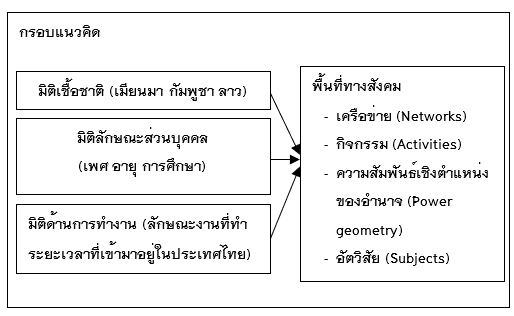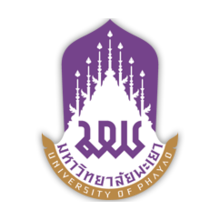Social Space of Transnational Migrant Workers from Myanmar, Lao PDR, Cambodia in Bangkok and Adjacent Provinces
Keywords:
Transnational Migrant, Migration, Social SpaceAbstract
This study examines the social space of Myanmar, Lao and Cambodian workers using the concepts of migration, mobility, and social space. The social space in this study is defined as boundaries and freedom to live in a society that is under the relationship of power and the position of power relations which is made up of natural (physical, geographical) social and network and relationship patterns in society. This study used semi-structured interviews with 278 Myanmar, Cambodia and Laos migrant workers. The questions for interviews were translated into 3 languages: Myanmar, Lao and Cambodian. Descriptive Statistics, Mean Analysis, Standard Deviation of Data and F-test Statistics were used.A numerical measure of social space was calculated which the maximum score is 35.
The study shows that the overall mean social space is 17.6. Lao workers have the highest measure of social space in Thailand, at 20.3, followed by Cambodian workers (17.0) and Myanmar workers (16.9). Considering social space by gender and nationality, Lao female workers scored highest. Their scores were and significantly higher than Lao male workers.
References
กฤตยา อาชวนิจกุล. (2544). ปัญหาการจัดการผู้อพยพจากประเทศพม่า. ใน อัมพร จิรัฐติกร (บรรณาธิการ). ไทยกับพม่า: ข้อควรทำและไม่ควรทำ. กรุงเทพฯ: โครงการอาณาบริเวณศึกษา 5 ภูมิภาค, 132-166.
กฤตยา อาชวนิจกุล และคณะ. (2543). เพศ อนามัยเจริญพันธุ์และความรุนแรง:ประสบการณ์ชีวิตของแรงงานอพยพจากประเทศพม่า. นครปฐม: สถาบันวิจัยประชากรและสังคม.
กาญจนา แก้วเทพ. (2549). ศาสตร์แห่งสื่อและวัฒนธรรมศึกษา. กรุงเทพฯ: เอดิสันเพรสโปรดักส์.
มนทกานต์ ฉิมมามี และพัชราวลัย วงศ์บุญสิน. (2557). ทุนทางสังคมกับการพัฒนาทุนมนุษย์ของแรงงานข้ามชาติพม่า ลาว และกัมพูชา หลังย้ายถิ่นมาในประเทศไทย. วารสารวิจัยสังคม, 37(2), 195-242.
สำนักบริหารแรงงานต่างด้าว. (2558). วารสารสถิติจำนวนคนต่างด้าวที่ได้รับอนุญาตทำงานทั่วราชอาณาจักร ประจำปี 2558. จาก http://wp.doe.go.th/wp/images/statistic/sy/sy2557.pdf.
องค์การระหว่างประเทศเพื่อการโยกย้ายถิ่นฐานและศูนย์วิจัยการย้ายถิ่นแห่งเอเชีย. (2556). การเปลี่ยนแปลง รูปแบบการย้ายถิ่นของแรงงานพม่าและผลกระทบต่อประเทศไทย. กรุงเทพฯ: องค์การเพื่อการโยกย้ายประเทศเพื่อการตั้งถิ่นฐาน สำนักงานกรุงเทพฯ ประเทศไทย.
Bylander, M. (2019). Is regular migration safer migration? Insights from Thailand. Journal on Migration and Human Security, 7(1), 1-18.
Faist, T. (2013). The mobility turn: a new paradigm for the social sciences?. Ethnic and Racial Studies, 36(11), 1637-1646.
Fellmann, J. D., Arther, G., & Judith, G. (1997). Human Geography Landscape of human activities. New York: McGraw-Hill.
Huguet, J., Chamratrithirong, A., & Richter, K. (2011). Thailand Migration Profile in JW Huguet, A. Chamratrithirong (eds), Thailand Migration Report 2011. Bangkok: International Organization for Migration, 7-16.
Sampson, I. A., Miles, G. M., & Piano, E. (2020). “Undocumented, unregistered and invisible”: an exploratory study of the reasons for and effects of migrating to Thailand of Cambodian young people. International Journal of Sociology and Social Policy, 41(7), 862-874.
Urry, J. (2011). Mobilities: new perspectives on transport and society. Surrey: Ashgate Publishing, Ltd.
Wiley, S. B. C., Sutko, D. M., & Moreno Becerra, T. (2010). Assembling social space. The Communication Review, 13(4), 340-372.

Downloads
Published
How to Cite
Issue
Section
License
Copyright (c) 2023 Phayao University

This work is licensed under a Creative Commons Attribution-NonCommercial-NoDerivatives 4.0 International License.
ผู้นิพนธ์ต้องรับผิดชอบข้อความในบทนิพนธ์ของตน มหาวิทยาลัยพะเยาไม่จำเป็นต้องเห็นด้วยกับบทความที่ตีพิมพ์เสมอไป ผู้สนใจสามารถคัดลอก และนำไปใช้ได้ แต่จะต้องขออนุมัติเจ้าของ และได้รับการอนุมัติเป็นลายลักษณ์อักษรก่อน พร้อมกับมีการอ้างอิงและกล่าวคำขอบคุณให้ถูกต้องด้วย
The authors are themselves responsible for their contents. Signed articles may not always reflect the opinion of University of Phayao. The articles can be reproduced and reprinted, provided that permission is given by the authors and acknowledgement must be given.







